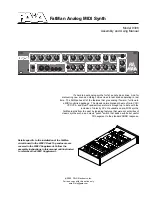
5-26
Descriptions of Parameters
Setup Editor Parameters
The Arpeggiator Menu
Arpeggiator Activation (Arp Active)
Enables or disables the arpeggiator for the setup. If this parameter’s value is
Off
, then you won’t
hear arpeggiation for any notes in any zone of the setup, regardless of the settings for any of the
other arpeggiator parameters.
In most setups, you can press Amber Switch
D
to activate the arpeggiator (in these setups,
Amber Switch
D
sends MIDI 116, ArpOn. You can program any physical controller (typically a
switch controller to activate the arpeggiator by setting its On Ctrl parameter to
116
, and its On
Value parameter to any value from
64
to
127
.
Arpeggiator Region, Lower Limit (Low) and Upper Limit (Hi)
Determines, in part, which notes you can arpeggiate. All notes, in all setup zones, that are
between the notes specified by Low and Hi (including the notes specified by Low and Hi) get
arpeggiated when
both
of the following conditions are met:
•
The value of the ArpActive parameter is
On
•
The value of the Zone Enable parameter for that zone is
On
Zone Enable
Determines whether the current zone can be arpeggiated under any circumstances. If the value
is
Off
for a zone,
none
of the notes within that zone’s key range get played by the arpeggiator. If
the value is
On
(and the arpeggiator is active), notes within that zone’s key range get played by
the arpeggiator if
either
of the following conditions is met:
•
The note is within the arpeggiator region (as defined by the Low and Hi parameters); in this
case it becomes one of the latched notes
•
The note isn’t within the arpeggiator region, but
is
within the range of the arpeggiator’s
transposition (as defined by the Shift Limit parameter); in this case it doesn’t get latched, but
still gets played
Take a look at Figure 4-1 on page 4-33. The Zone Enable parameter determines whether
arpeggiated notes get sent to a particular zone. Then the zone’s parameters process the notes,
and if they’re within the zone’s key range, the notes get played.
Latch Mode
Determines the manner in which notes get latched. There are six possible values:
Keys
The arpeggiator plays only while you are holding one or more keys down (or holding note
triggers on). As you play different notes, they get added to the arpeggiator, and as you release
notes, they get taken out. If you play notes faster than the arpeggiator’s current tempo, each
subsequent note gets added to the arpeggiation at the next division of a beat. This can cause a
lag between the time you play the note and the time you hear it in the arpeggiation.
















































